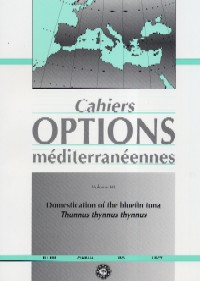| Article précédent | p. 181-184 | Article suivant |
Second crop alternatives for winter period in wheat-cotton and cotton-cotton cropping pattern in Mediterranean ecologies
The absence of winter crops for 5 to 6 months in traditional cotton-cotton and cotton-wheat rotation patterns in Mediterranean coastal regions involves the use during this period of intercropped annual legumes and grasses for forage production. This would respond to the pressing demand from livestock breeders. In order to determine the potential of the different annual crops and their associations, two experiments were conducted in the region of Bornova-Izmir. Hordeum vulgare, Triticale, Lolium multiflorum, Vicia sativa, Vicia faba and Trifolium resupinatum crops as well as each grass-legume association have been compared regarding fresh and dry weight yield and crude protein. The following associations have yielded the best results both at agricultural and at economic levels: Hordeum vulgare plus Vicia sativa, Hordeum vulgare plus Vicia faba, Lolium multiflorum plus Vicia sativa and Hordeum vulgare plus Trifolum resupinatum.
- [ Afficher ]
- [ Télécharger ]
- [ Exporter la citation ]
Vous pouvez télécharger la citation au format :
- [ Imprimer ]
-
Mots-clés
BLE, GOSSYPIUM, PHYTOECOLOGIE, ROTATION CULTURALE, ZONE MEDITERRANEENNECiter cet article
Avciouglu R., Geren H., Demiroglu G. Second crop alternatives for winter period in wheat-cotton and cotton-cotton cropping pattern in Mediterranean ecologies. In : Ferchichi A. (comp.), Ferchichi A. (collab.). Réhabilitation des pâturages et des parcours en milieux méditerranéens . Zaragoza : CIHEAM, 2004. p. 181-184. (Cahiers Options Méditerranéennes; n. 62). 11. Réunion du Sous-Réseau Ressources Fourragères Méditerranéennes du Réseau Coopératif Interrégional FAO-CIHEAM de Recherche et Développement sur les Pâturages et les Cultures Fourragères, 2002/10/29-2002/11/01, Djerba (Tunisia). http://om.ciheam.org/om/pdf/c62/04600153.pdf



